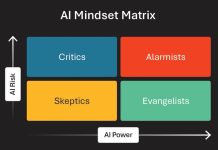In spring 2024, conversations and presentations at the Gartner CSO and Sales Leader Conference ranged from the importance of strategic adaptability to the need for honest assessments of sales cultures, keys to hiring smarter, and the urgency to align sales and marketing efforts.
What a difference a year makes.
Those capabilities continue to be vital to B2B sales success, but this year’s Gartner CSO and Sales Leader Conference, held May 20-21 in Las Vegas, was dominated by two omnipresent letters — AI.
Artificial intelligence — specifically, AI’s role in enhancing every aspect of corporate operations — is a vital and vexing concern for business leaders worldwide. C-level executives want clarity on how much and how quickly to invest in AI. Mid-level managers are scrambling to get their heads around how to incorporate AI into their go-to-market strategies.
And workers at all levels continue to ask, “Is AI going to replace me?”
A Transformative Time to Lead
To be sure, AI has been in the conversation at past Gartner conferences (both sales and marketing related), as well as other sales conferences. This year, however, it is dominating the conversation.
To emphasize the major pivots that companies must take to remain competitive in an AI-dominated world, Gartner gave its sales conference the theme “Radical Change in the DNA of High-Performing Sales Organizations.”
“It is a really rare time to be a leader in sales because this epic profession is going through an awakening, and all of you are the chosen leaders to guide its transition,” Gartner for Sales Vice President Analyst Dan Gottlieb stated in his opening-day keynote address.
“Agentic AI gives us the power to deconstruct the craftsmanship of sales and rebuild it into a new way of working. We’re waking up in a whole new world,” Gottlieb continued. “You’re getting questions that you’ve never been asked before. Your boards, customers, CEOs and executive peers… They’re all putting pressure on sales to figure out how to chase a brand new revenue productivity frontier.”
This transformation, Gottlieb said, will occur in days and weeks, not years. Companies that fail to develop a formal AI for sales adoption strategy and that fail to hire with AI skills in mind will be left behind.
“We see the next one to two years — in our world, four to eight quarters — as the window to get a competitive advantage with this technology, because we think it’s going to be mainstream in three to five,” he said.
He cautioned sales managers not to wait for those higher up in their organization to lead the AI push. AI skills building can be a department resolution — and even a personal one.
“Some of you may thinking, ‘My company is not AI-forward. This, not my job.’ You’re missing the point. The great sales awakening isn’t about your company; it’s about you and what kind of leader you want to be with this opportunity,” Gottlieb said.
“If you see this moment for the tremendous opportunity it really is, then you’re about to go through a period of massive personal and professional growth. That should scare you, but that fear you feel is the invigorated feeling of being alive that tells you how awesome it is to be a leader right now.”
With his strong call to action firmly made, Gottlieb provided specific steps that sales leaders can take to move AI initiatives forward.
Set the Pace
Ask yourself what outcomes you want to achieve with your AI investment. Gottlieb said there are two general approaches when it comes to AI adoption in business: steady and accelerated.
Companies that adopt a steady approach spend on AI out of a sense of obligation, focus goals on time savings, and generally have modest ambitions in terms of outcomes.
Companies that take an accelerated approach are focused on cost savings and growth through AI-driven improvements. Their ambition is to be an AI pioneer, and they are not afraid to take risks.
Design a Sales AI Transformation Portfolio
As with personal investments, laying out AI investment visually in a portfolio manner will help you measure your current approach and make necessary adjustments to achieve your goals. It allows leaders to more clearly assess the AI invest- ments they may wish to make based on cost, value and risk.
Gartner has identified three groups that companies generally fall into in terms of AI spend:
- Defend Strategy – These companies mostly seek time savings from AI and are simply trying to defend their market positions.
- Extend Strategy – These companies believe AI investments have a direct impact on leading indicators of growth or provide significant cost-of-sales savings.
- Upend Strategy – These companies pursue self- disruption because they believe significant transformation begets significant revenue opportunities.
As with investment portfolios, different AI spend portfolios produce different results. Gottlieb shared three portfolio styles and the results that can be expected from each:
• FOMO – Adopts a classic AI steady pace in which approximately 80% of AI initiatives are focused on time savings with some modest exploration of growth and cost savings. About six out of 10 companies currently have this type of AI portfolio, according to Gartner data.
• Best Return – Approximately 80% of investments are directed to extend spend initiatives while 10% is allotted to defend spend and 10% to upend spend initiatives. About three out of 10 companies currently have this type of portfolio.
• Disruptor – According to Gottlieb, these portfolios are currently reserved for industries that are rapidly being disrupted by AI and organizations that have an intensive interest in AI transformation. About one in 10 companies currently have a disruptor portfolio.
The Best Return portfolio provides a solid path to direct revenue impact because “you’re trying to take on what’s possible with the technology today while also embracing the challenges of making it work at scale,” Gottlieb said.
Creating your AI portfolio gives you a way to frame how you talk about AI and how it connects to your goals. “It turns your portfolio into a narrative, and I know we love a good narrative in sales,” Gottlieb said.
Future Fit Your Personnel
A narrative is great, but it isn’t what accomplishes goals — people do, Gottlieb said. He cautioned his sales leader audience that the way they are qualifying new hires is not ideal for an AI-skilled work force.
A future-fit sales talent strategy prioritizes upside over experience, yet sales job postings continue to prioritize experience as a key qualifier while failing to screen at all for AI skills.
“High upside talent doesn’t always have sales experience,” Gottlieb said. “If we have an intelligently deployed agentic AI platform, that’s a new way to think about making a new rep successful. If we can deploy AI to scale knowledge, make execution repeatable and execute work faster, we can de-risk how high upside talent executes in the role. We can accelerate their ramp to confidence, competence and closing.”
Instead of sales experience, he recommends looking for candidates with a growth mindset, proven flexibility when faced with challenges, and familiarity and comfort with AI tools.
Prepare Your Organization to Become Agentic
The No. 1 thing holding companies back from achieving successful AI transformations is a lack of clarity on which AI use cases will drive ROI. This step is all about getting people focused on the most important activities that will result in a successful AI-centric transformation.
It entails breaking sales roles down into actions, hypothesizing the agentic AI accelerators that can take over or speed up those actions, and then adapting those roles to incorporate AI agents. Gartner has discovered companies that do this are 2½ times more likely to transform successfully and achieve commercial objectives (or as Gottlieb puts it, “hit their numbers”).
The Time to Invest Is Now
Successful AI transformations won’t occur without time commitment. Gottlieb said, “To quote my mother-in-law, you have to put your attention on your intention.’”
Gartner clients that have taken the lead on AI transformation in sales have biweekly meetings to update sales leaders on progression. Teams that are executing the transformation programs are meeting two or three times per week. AI initiatives are on agendas at sales kickoffs, quarterly updates and annual planning sessions.
“Sales leaders driving results are not letting this significant opportunity slip through their fingers with hope and luck. They’re wrestling with it and saying, ‘I’m going to make sure that we’re doing the right thing, placing the right bets, and that we’re going to win with AI,’” Gottlieb said.
A personal finance mantra is the time to start investing is now. It’s no different for companies wanting to acquire agentic AI proficiency.
“This is your moment to get that swagger and set the tone to chase a new productivity frontier,” said Gottlieb. “Improvement doesn’t come drastically or immediately. But if you start today, by 2027, you will realize exponential improvements of revenue, cost of sales and AI maturity. Can you imagine if you wait three years to start this?”





